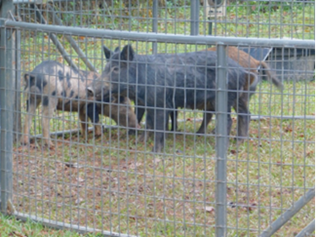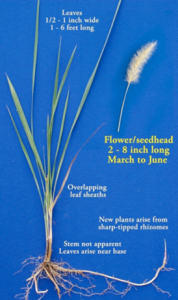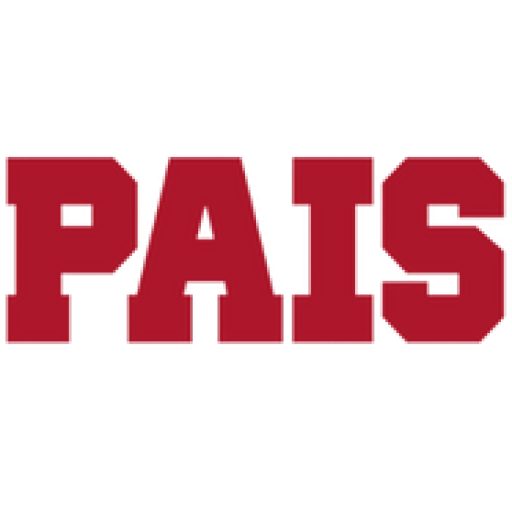Invasive Species Management

Goal
Provide stakeholders with the knowledge, tools, and manpower to combat threats resulting from invasive species.
What Are Invasive Species:
An invasive species is a species found outside its native range resulting from human activity that becomes ecologically established and increases in abundance at the expense of native species.
- Invasive species threaten 49% of the United States’ endangered species.
- They are particularly harmful to bird and plant populations, but no organismal group is immune.
- Non-native species in the U.S. are estimated to cause $137 billion in damage annually.
Cogongrass (Imperata cylindrica) Management:
Cogongrass is an aggressive invader of natural and disturbed areas throughout the Southeast. It is also classified as a federal noxious weed. Cogongrass disrupts ecosystem functions, reduces wildlife habitat, decreases tree seedling growth and establishment success, and alters fire regimes and intensity. Recognizing the presence of cogongrass is necessary before beginning any land management activities. While other species may look similar, cogongrass has a unique combination of characteristics that make field identification possible.
Cogongrass grows best in full sunlight to partial shade and can be found across a wide range of habitats, including roadsides, rights-of-ways, open forests, new forest plantations, old fields, and pastures. It occasionally occurs in landscape plantings and lawns. It does not do well in continually wet sites or in areas with frequent tillage.

Considerations for the Use of Herbicides:
- Always spray away from you, and downwind.
- Don’t walk through freshly sprayed areas (carefully walk backward).
- ALWAYS wear glasses, unlined liquid-proof gloves, long sleeves, and long pants before any spraying commences.
- Avoid wearing anything made of leather or canvas – these materials absorb and retain pesticides.
- Before using an herbicide, carefully read the label. The label is the law.
- Hands must be washed when finished spraying, before using the restroom, or before any food, drink, or tobacco products are consumed/used.
- Have an extra set of clothes close by in case of any spills.
- Keep people and animals away during herbicide application and until the herbicide has dried.
- Exercise caution spraying around water.
- Should any spills occur, control the leak or spill, contain the spill area, and then clean it up. For cleanup information read the herbicide label and call the National Pesticide Information Center at (800) 858-7378.
- Spray very lightly under or around desired vegetation and avoid the use of herbicide if possible. Too much herbicide can kill trees!
- If you accidentally spill herbicide on yourself or on your clothing, quickly get undressed and wash herbicide off. If clothing is affected, promptly put in washing machine, by themselves and wash in warm water.
Feral Swine (Sus scrofa) Management:
Feral swine, estimated to number at least 64 million nationally, have had tremendous impacts on a variety of crops, as well as transmitting a variety of human and livestock diseases. It has also been suggested that feral swine may be a major factor in the incidence of pine decline complex, a major forest health issue which is on the increase in southern pine forests. In the United States, annual expenses related to crop damage and animal control related to feral swine exceed $1.5 billion.
Top 10 Do’s in Feral Swine Control:
- Be patient– Scout, use bait stations and figure out what’s there. Pre-bait, catch pigs at the right time and follow up with monitoring.
- Some pigs are picky eaters– Try different baits until the pigs consistently come in, starting simple with corn. Activity may vary during the year based upon availability of other food sources.
- Know what you are dealing with– Use game cameras, conduct a survey to know what is present. Identify individuals’ pigs/sounders by size, sex, and color.
- The end– Kill adult pigs first and before the day gets hot. Euthanize pigs from an elevated position.
- Pigs are adaptable– Employ different methods, utilize a removal management plan, and utilize aerial imagery for hotspots and signs of swine.
- Technology– Check service areas, camera batteries and protect cameras from weather and livestock.
- Observe the surrounding area– Scout area thoroughly, finding areas in which pigs are active. During hot periods look near rivers or swamps for signs. Finally, confirm the presence of pigs.
- Maintain you trap and additional equipment.
- Pre-baiting is important– Allow pigs to acclimate to the trap, utilize a bait trail from the gate to the interior of the trap. Place bait in areas where damage is occurring.
- Pay attention to trap details– Ensure the trap is set up properly. Install permanent traps in known dispersal areas.
Our Methods
Herbicide Preparation:
Interns will spray infested area as directed by our coordinator. No more than 28 gallons of herbicide shall be used per landowner. The concentration consists of glyphosate and imazapyr.
Feral Swine Traps:
A variety of hog traps are employed (net traps, coral traps and drop traps), except for Coastal Alabama and East Mississippi where the PIG BRIG™ will be solely used.
- Pig Brig
- Game Changer
- BoarBuster
- JagerPro
- Big Pig
Additional Information
Invasive species will never truly be eradicated, but we should all do our part to manage them and prevent them from further spreading. If you would like assistance in controlling any cogongrass or feral swine on your property. If you would like assistance in any of these areas, please initiate process by completing PAIS Survey.
Address
Math and Science Building
University of West Alabama
Livingston, AL 35470
Call Us
Drew Busby: (205) 652-4559
Aubree Plymale: (205) 652-3840
Drew Busby: dbusby@uwa.edu
Aubree Plymale: plymalea@uwa.edu
